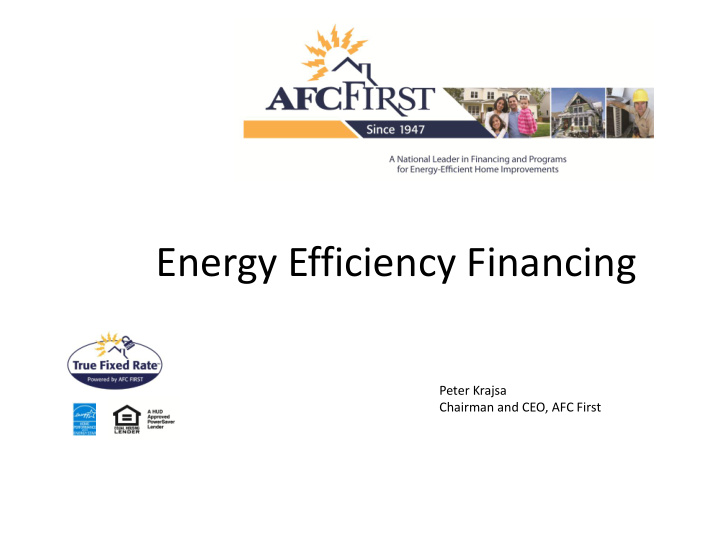



Energy Efficiency Financing Peter Krajsa Chairman and CEO, AFC First U PDATE 05/08/12
AFC First – A National Leader in Residential Energy Efficiency Lending and Programs • Contractor-driven, energy related home improvement lending is our primary business . Founded in 1947, our complete focus since 1999 has been assisting high- quality contractors and motivated consumers to affordably install energy related home improvements. • AFC First is one of only three Fannie Mae approved Energy Lenders in the U.S. and considered a national leader in this market • National footprint with over 3,000 Approved Contractors, Manufacturer, Utility and State and Municipal Partners and Sponsors • We operate the Green Energy Training Center & Academy for Home Performance, BPI and contractor sales training • Creating new Green Energy Federal Credit Union for program expansion • Named nation ’ s first private Home Performance with ENERGY STAR sponsor by US DOE on October 1, 2011 (non-utility, state, municipal or non-profit) • Selected as one of 18 national Power Saver pilot lenders by HUD and DOE
Overview of Keystone HELP • Keystone HELP is one of the most successful programs in the nation with recognition by ACEEE • Over 10,000 and $70 million in unsecured loans • Over 1,000 and $20 million in secured loans • 85% for Single Measure (HVAC, Insulation etc) • 70% Approval Rate • 1.62% Cumulative Charge Off for Unsecured Loans Since Inception Loans Made by Credit Score Charge Off % by Credit Score 640 7.00% 8% 6.00% 680 5.00% 19% 4.00% 3.00% 2.00% 720 Plus 1.00% 73% 0.00% 640 680 720 Plus 3
Broad Credit Approval for Keystone HELP loans • Homeowners who own and are making qualifying improvements to their 1 to 2 unit primary residence located in Pennsylvania are eligible • Tier 1 to $15,000 • 680 FICO minimum • 50% Debt to Income Ratio • No Bankruptcy in the past 7 years • Tier 2 to $7,500 • 640 FICO minimum • 45% Debt to Income Ratio • No Bankruptcy in the past 5 years • Secured loan options (PowerSaver) to $35,000 • 620 FICO minimum • 45% Debt to Income Ratio • No Bankruptcy in the past 2 years 4
Warehouse for Energy Efficiency Loans • Based upon the success of Keystone HELP, PA Treasury recognized an opportunity to execute a secondary market sale to recapitalize its initial investment in the program • However, the lack of a functioning secondary market has made such a transaction difficult to arrange • PA Treasury decided to work with national partners to develop a financing facility to aggregate, package and sell similar assets from around the country • This facility – WHEEL – is intended to stimulate the development of a national secondary market for energy efficiency financing assets
WHEEL Structure and Financing • A firm has been selected to act as an aggregation conduit and master servicer, with loans transferred to a remote (special purpose vehicle) SPV owned by the firm • The aggregation conduit will acquire loans at par from approved originators and serviced by approved subservicers (originators and servicers may, but are not required to be, the same entities) • Senior capital for loan aggregation is expected to come from the PA Treasury and Citigroup in equal proportions, with subordinated capital coming from utilities or other state and local partners • When sufficient scale is reached, the pool of loans in the SPV will be securitized and sold as a rated instrument to secondary market investors • Current proposed schedule targets the first quarter of 2013 for all appropriate contracts, agreements, etc. to be executed and for loan aggregation to commence
The Future… • Foundation of WHEEL program to create national secondary market • Improved integration with utility programs to offer additional incentives for specific measures • On-Bill financing • Greater emphasis on Whole House, simplifying and demystifying process • More automation, less paperwork for contractors • Full integration of Power Saver loans 7
Recommend
More recommend